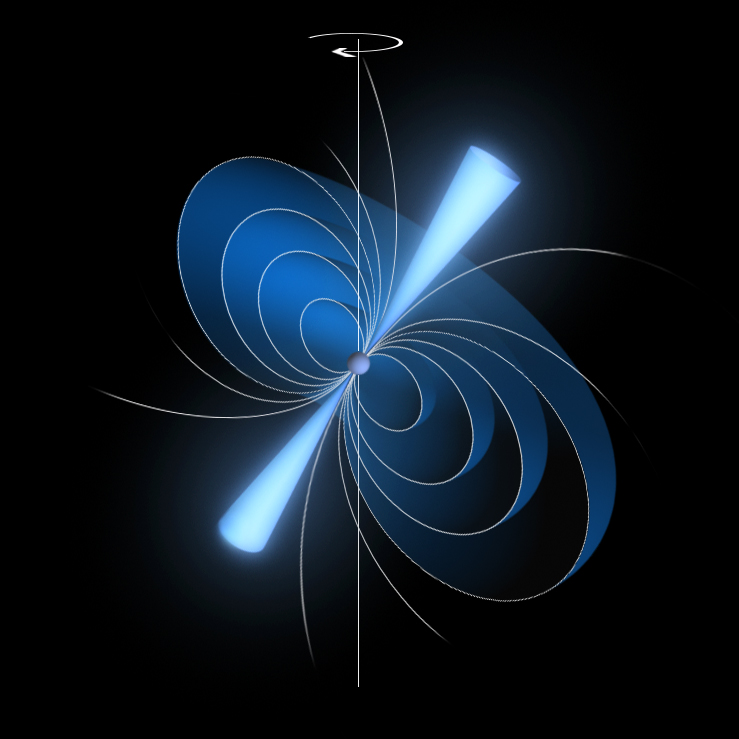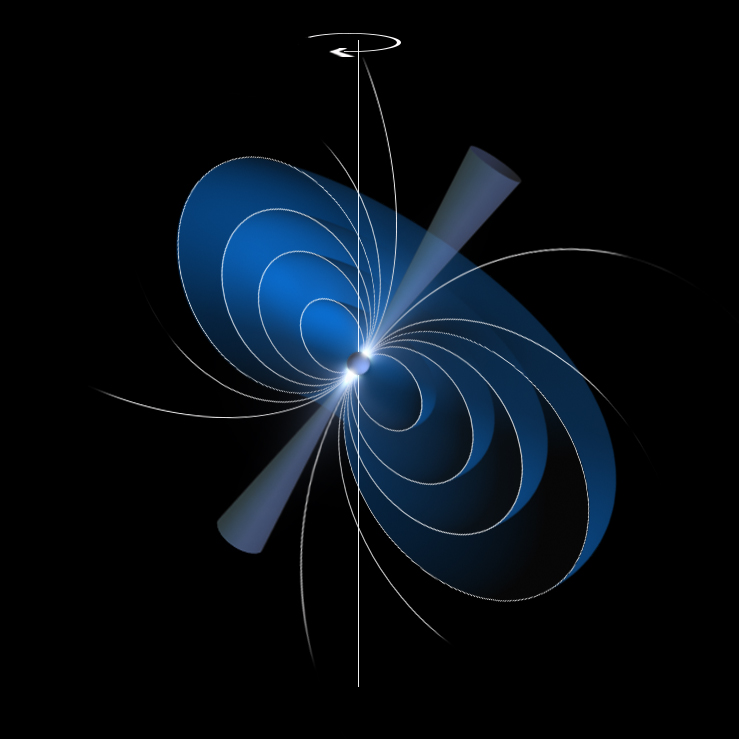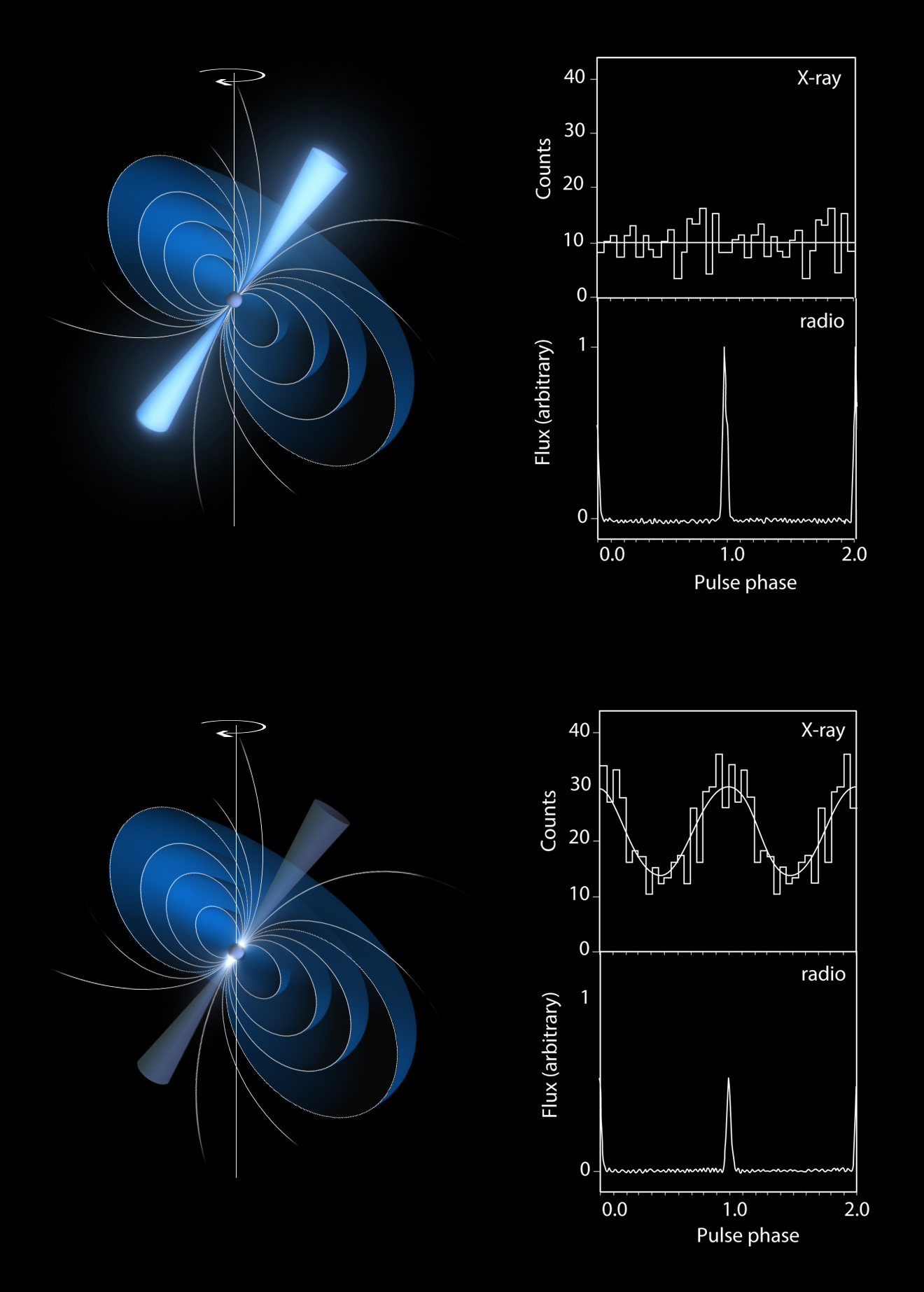
Pulsars are small spinning stars about 20 km in diameter -the size of a small city – with a mass that roughly compares to the mass of our Sun. They have a strong magnetic field that is approximately one million times stronger than the fields scientists can make in laboratories on Earth. The pulsar emits a beam of radiation. As the star spins and the radio beam sweeps repeatedly over Earth we detect a short pulse of radiation, a bit like a lighthouse. Some pulsars emit radiation across the entire electromagnetic spectrum, including both X-ray and radio wavelengths. Although pulsars were discovered more than 40 years ago the exact mechanism by which pulsars shine is still unknown.
It has been known for some time that some radio pulsars flip their behaviour between two (or even more) states, changing the pattern and intensity of their radio pulses. The moment of flip is both unpredictable and sudden (often within a single rotation period). It is also known from satellite-borne telescopes that a handful of radio pulsars can also be detected at X-ray frequencies. However, the X-ray signal is so weak that nothing is known of its variability – could it be that the X-rays also flip?
Flips

The scientists studied a particular pulsar called PSR B0943+10, one of the first pulsars discovered. The pulses from PSR B0943 + 10 change in form and brightness every few hours, and these changes happen within about a second. It is as if the pulsar has two distinct personalities. As PSR B0943+10 is one of the few pulsars also known to emit X-ray radiation, knowing how this pulsar behaved in X-rays during the ‘radio changes’ could provide new insight into the nature of the emission process.
Since the source is a weak X-ray emitter, the team used the most sensitive X-ray telescope in operation, the ESA-funded XMM-Newton. The observations took place over six separate sessions of about six hours in duration. To identify the exact flips in the pulsar’s radio behaviour the X-ray observations were tracked simultaneously with two of the most powerful radio telescopes in the world, GMRT and LOFAR With the ground telescope LOFAR Joeri van Leeuwen and Jason Hessels (ASTRON/UvA) could non-stop determine in which radio state the pulsar was. The LOFAR telescope is designed and built by ASTRON, the Netherlands Institute for Radio Astronomy and the research was supported by the international LOFAR team. Van Leeuwen: “Even in its test phase LOFAR proved to be the world’s most sensitive radio telescope for pulsars. That is why we were able to pinpoint the flips of the pulsar to the second.”
Two X-ray states as well

The results were totally surprising. The X-rays did indeed change their behaviour synchronously with the radio emission, as might have been expected. But in the state where the radio signal is strong and the pulses are clear, the X-rays were weak. And when the radio emission switched to weak the X-rays intensified. “To our surprise we found that when the brightness of the radio emission decreased to half the original brightness, the X-ray emission brightened by a factor of two!” says project leader Wim Hermsen (SRON Netherlands Institute for Space Research/UvA). ‘And only then the X-ray emission is pulsed. Lucien Kuiper (SRON), who scrutinised the data from XMM-Newton , concluded that this strongly suggests that a temporary “hotspot” close to the pulsar’s magnetic pole switches on and off with the change of state.
Most striking was that this metamorphosis takes place within seconds, after which the pulsar remains stable in its new state for a few hours. Why a pulsar should undergo such dramatic and unpredictable changes cannot be explained by current theory. It strongly suggests a quick change of the entire magnetosphere”.
Tale of the unexpected
This unexpected chameleon-like behaviour of the radio pulsar PSR B0943+10 bolsters fundamental research into the physical processes which occur in the extreme conditions which occur in the magnetosphere of pulsars, 45 years after the discovery of neutron stars. Wim Hermsen and his colleagues have been granted new observation time on XMM-Newton. By combining their X-ray observations with observations from a number of radio telescopes (Westerbork, GMRT and Lovell telescopes) the astronomers will also be able to simultaneously observe pulsar PSR B1822-09. In radio wavelengths PSR B1822-09 shows similar flips as PSR B0943+10.
Team
The research was led by Wim Hermsen (SRON Netherlands Institute for Space Research, UvA), Lucien Kuiper and Jelle de Plaa (SRON), Jason Hessels and Joeri van Leeuwen (ASTRON en UvA), Dipanjan Mitra (NCFRA-TIFR, Pune, India), Joanna Rankin (University of Vermont, Burlington, VS), Ben Stappers (University of Manchester, UK), Geoffrey Wright (University of Sussex, UK). The Pulsar Working Group and the Builders Group from the LOFAR-telescope, which was at the time still in the commissioning phase, gave support to these observations. The results of this research, entitled: Synchronous X-ray and Radio Mode Switches: a Rapid Transformation of the Pulsar Magnetosphere will appear in Science on January 25.


